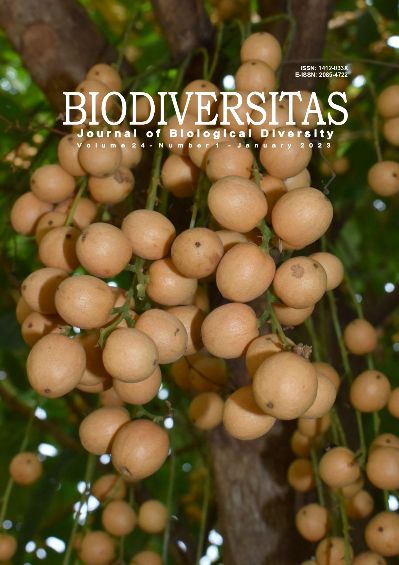Potential antibacterial and antioxidant activities of ten essential oils from East Kalimantan, Indonesia
##plugins.themes.bootstrap3.article.main##
Abstract
Abstract. Aryani F, Kusuma IW, Meliana Y, Sari NM, Kuspradini H. 2023. Potential antibacterial and antioxidant activities of ten essential oils from East Kalimantan, Indonesia. Biodiversitas 24: 665-672. This study aimed to evaluate ten aromatic essential oils' antibacterial and antioxidant activity. Ten aromatic herbs were distilled using the water and steam distillation method. The essential oils obtained was tested for its physical properties, color, refractive index, and specific gravity. The refractive index was measured using a refractometer. On the other hand, specific gravity was measured using a pycnometer. Antioxidant activity testing using the free radical DPPH (2,2-diphenyl-1-picrylhydrazyl) and ascorbic acid was used as the control. Antibacterial activity testing using the agar diffusion method and pathogenic bacteria, namely Salmonella typhi, Escherichia coli, Propionibacterium acnes, and Staphylococcus aureus. Chloramphenicol was used as a positive control and acetone as a negative control. The results obtained essential oils with a slightly yellowish to brownish-yellow color. The highest refractive index and specific gravities were Syzygium aromaticum oil, and the smallest was Litsea elliptica and Eucalyptus pellita oils. The results of the antioxidant activity test carried out at a concentration of 500 µg/mL range from 4.82 % to 85.06 % inhibition and showed that the highest inhibition was Cymbopogon citratus and Syzygium aromaticum by 55.76 % and 85.06%, respectively. Antibacterial activity of ten essential oils showed a varied inhibition zone (0-60 mm) against S. typhi, E. coli, P. acnes, and S. aureus. The oil from Cymbopogon citratus and Citrus hystrix had the highest activity against S. typhi (60 and 21.67 mm, respectively), E. coli (60 and 20.33 mm, respectively), P. acnes (60 and 31.11 mm, respectively) and S. aureus (60 mm and 17.89 mm, respectively). The research results showed that the essential oils in this study had the potency for development as a natural antibacterial and antioxidants agents.

